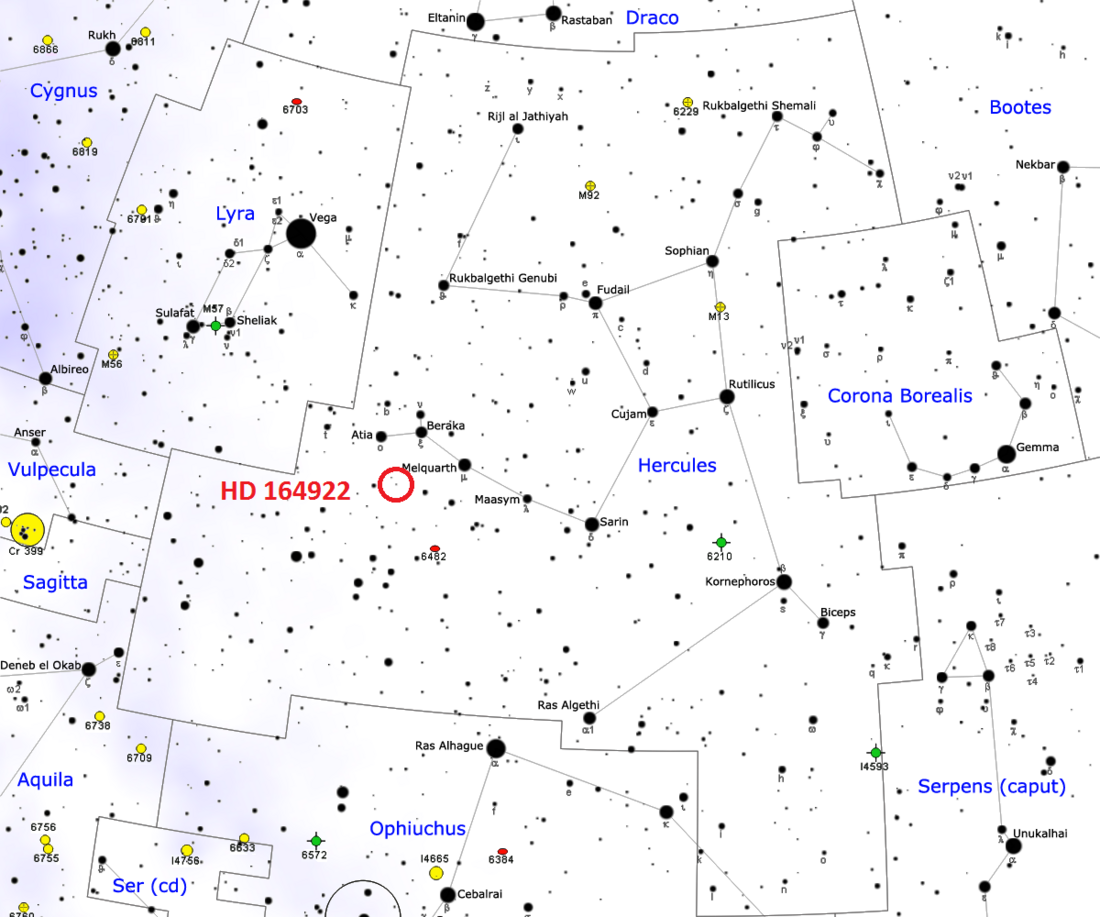HD 164922 is a seventh magnitude G-type main sequence star in the constellation of Hercules. To view it, binoculars or a telescope are necessary, as it is too faint to be visible to the naked eye. It is 71.7 light-years (22.0 parsecs) distant from the Earth.[1] It will soon evolve away from the main-sequence and expand to become a red giant.[citation needed]
| Observation data Epoch J2000.0 Equinox J2000.0 | |
|---|---|
| Constellation | Hercules |
| Right ascension | 18h 02m 30.86234s[1] |
| Declination | +26° 18′ 46.8050″[1] |
| Apparent magnitude (V) | +6.99[2] |
| Characteristics | |
| Spectral type | G9V[3] |
| B−V color index | 0.799±0.005[2] |
| Astrometry | |
| Radial velocity (Rv) | 20.16±0.12[1] km/s |
| Proper motion (μ) | RA: 389.772 mas/yr[1] Dec.: -602.431 mas/yr[1] |
| Parallax (π) | 45.4954 ± 0.0167 mas[1] |
| Distance | 71.69 ± 0.03 ly (21.980 ± 0.008 pc) |
| Details | |
| Mass | 0.874 ± 0.012[3] M☉ |
| Radius | 0.999 ± 0.017[3] R☉ |
| Luminosity | 0.703 ± 0.017[3] L☉ |
| Surface gravity (log g) | 4.387 ± 0.014[3] cgs |
| Temperature | 5390±30[2] K |
| Metallicity [Fe/H] | 0.16 ± 0.05[3] dex |
| Rotation | 42.3+1.3 −0.7 d[2] |
| Rotational velocity (v sin i) | <2.0[2] km/s |
| Age | 13.4,[4] 9.58+1.99 −1.55[2] Gyr |
| Other designations | |
| Database references | |
| SIMBAD | data |
Nomenclature
The name HD 164922 derives directly from the fact that the star is the 164,922nd star listed in the Henry Draper catalog. The designation b for its planet derives from the order of discovery. The designation of b is given to the first planet found orbiting a given star, followed by the other lowercase letters of the alphabet.[5] In the case of HD 164922, only one was discovered, which was designated b, followed by three more planets, which were designated c, d, and e.[3][6]
Stellar characteristics
HD 164922 is a G-type main sequence star that is approximately 87% the mass of and 99% the radius of the Sun. It has a temperature of 5390 K and is about 10 billion years old,[2] with estimates ranging as high as 13.4 billion years.[4] In comparison, the Sun is about 4.6 billion years old[7] and has a temperature of 5778 K.[8]
The star is metal-rich, with a metallicity ([Fe/H]) of 0.16, or 144% the solar amount. This is particularly odd for a star as old as HD 164922. Its luminosity (L☉) is 70% of the solar luminosity.[3]
Planetary system
On 15 July 2006, a long period Saturn-mass exoplanet was announced orbiting around HD 164922. This planet orbits at 2.11 AU from the star with a low eccentricity value of 0.05.[9]
Almost exactly ten years later in 2016, another exoplanet, though less massive than the first planet, was discovered orbiting farther in from the star. This planet has a minimum mass of nearly 13 times that of Earth, meaning it is possibly a Neptune-like planet.[3]
A third exoplanet, a hot super-Earth, was discovered in 2020,[2] and a fourth, Neptune-mass, in 2021.[6]
| Companion (in order from star) |
Mass | Semimajor axis (AU) |
Orbital period (days) |
Eccentricity | Inclination | Radius |
|---|---|---|---|---|---|---|
| d | ≥4.74±0.67 M🜨 | 0.1023±0.0012 | 12.4584+0.0019 −0.0023 |
0.18+0.17 −0.12 |
— | — |
| e | ≥10.52+0.99 −0.97 M🜨 |
0.2292+0.0026 −0.0027 |
41.763±0.012 | 0.086+0.083 −0.060 |
— | — |
| c | ≥14.3±1.1 M🜨 | 0.3411±0.0039 | 75.817+0.037 −0.038 |
0.096+0.088 −0.066 |
— | — |
| b | ≥0.344±0.013 MJ | 2.149±0.025 | 1,198.5+3.2 −3.1 |
0.065+0.027 −0.029 |
— | — |
See also
- List of exoplanets discovered between 2000–2009 - HD 164922 b
- List of exoplanets discovered in 2016 - HD 164922 c
- List of exoplanets discovered in 2020 - HD 164922 d
- List of exoplanets discovered in 2021 - HD 164922 e
References
External links
Wikiwand in your browser!
Seamless Wikipedia browsing. On steroids.
Every time you click a link to Wikipedia, Wiktionary or Wikiquote in your browser's search results, it will show the modern Wikiwand interface.
Wikiwand extension is a five stars, simple, with minimum permission required to keep your browsing private, safe and transparent.

